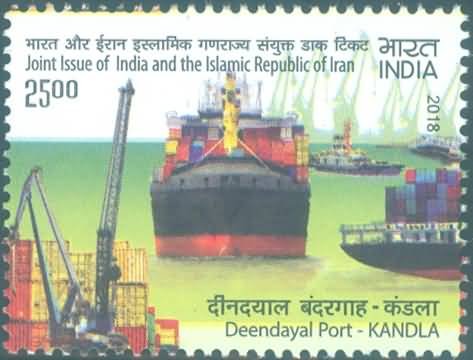India Iran Joint Issue

Technical Data
| Stamp Set | India Iran Joint Issue |
|---|---|
| Date of Issue | February 17, 2018 |
| Denomination | Rs. 25 |
| Quantity | 501,000 |
| Perforation | 13¾ x 13¾ |
| Printer | Security Printing Press, Hyderabad |
| Printing Process | Wet Offset |
| Watermark | No Watermark |
| Colors | Multicolor |
| Credit (Designed By) | Shri Kamleshwar Singh Smt. Alka Sharma |
| Catalog Codes |
Michel IN 3360A Stamp Number IN 3009 Yvert et Tellier IN 3050 Stanley Gibbons IN 3475 |
| Themes | Container Ships | Joint Issues | Ports | Trade |
India-Iran relations span millennia marked by meaningful interactions. The two countries shared a border till 1947 and share several common features in their languages, cultures and traditions. India and Iran established diplomatic links on March 15, 1950. In addition to the Embassy in Tehran, India has two Consulates in Iran, one in Bandar Abbas and other in Zahedan. The two countries have in place Bilateral Consultative Mechanisms at various levels which meet regularly. Foreign Offices of both countries also hold regular consultations on bilateral and regional issues.
India-Iran relationship enjoys economic and commercial ties covering many sectors though it has traditionally been dominated by Indian import of Iranian crude oil. The India-Iran bilateral trade during the fiscal year 2016-17 was USD 12.89 billion. India imported USD 10.5 billion worth of goods, mainly crude oil, and exported commodities worth USD 2.4 billion. Major Indian exports to Iran include rice, tea, iron and steel, organic chemicals, metals, electrical machinery, drugs/pharmaceuticals, etc. Major Indian imports from Iran include petroleum and its products, inorganic/organic chemicals, fertilizers, plastic and articles, edible fruits and nuts, glass and glassware, natural or cultured pearls, precious or semiprecious stones, etc.
An Indian Cultural Centre is currently functioning within the Embassy premises which was inaugurated in 2013. Iran has Cultural Centres in Delhi, Hyderabad and Mumbai. Indian Mission undertakes various cultural activities including Indian Cultural week, celebration of important days and events among others. The 3rd International Day of Yoga was celebrated at the Kendriya Vidyalaya school premises on June 21, 2017 in which more than 500 Iranians participated. Indian Embassy has been bringing out a bi-monthly magazine named “Aina-e-Hind” (Mirror of India) taking India to the drawing rooms of the general Iranian public.
The theme for India-Islamic Republic of Iran Joint Issue represents “trade and commerce connectivity” featuring Deendayal Port – Kandla from Gujarat, India and Shahid Beheshti Port – Chabahar from Iran. The Miniature sheet design has structures of the Ashokan Pillar with a Lion at the top from India and Achaemenid Griffin of Iran which shows the strong bond between architectural history of two great civilizations.
Deendayal Port – Kandla
Deendayal Port’s journey began in 1931 with construction of RCC Jetty by Maharao Khengarji. After partition, Deendayal Port’s successor city has consistently been ranked the No. 1 port in India for the year 2007-08 and since then has retained the position except one year (average over 8). On 31.03.2016; Deendayal Port created history by handling 100 million tons in a year – the first major port in the country to achieve this on a single port basis. Deendayal Port is a natural deep seaport in Kutch District of Gujarat state in western India, near the city of Gandhidham. Located on the Gulf of Kutch, it is one of major ports on west coast. Kandla was the chief seaport serving western India, after the partition of India, till the port of Karachi in Pakistan. It is located on the Gulf of Kutch on the North Western coast of India some 256 nautical miles southeast of the Port of Karachi and over 430 nautical miles north-northwest of the Port of Mumbai.
Shahid Beheshti Port – Chabahar
Chabahar Port is strategically located on Iran’s South Eastern Coast in the Sistan-Baluchistan Province. It lies in the Oman sea outside the Persian Gulf. The distance from Kandla to Chabahar is 550 nautical miles (approx 1018 km) and from Mumbai is 768 Nautical Miles (approx. 1422 km). The importance of Chabahar port is its potential to give India alternate access to Afghanistan. It has a huge commercial potential by offering access to the CIS countries, Russia and Europe through Iran.
India in partnership with Iran is developing Phase I of Shahid Beheshti Port – Chabahar. In 2016, the contract on Chabahar was signed which consists of Indian investment of USD 85 million for equipping the Chabahar port and Credit of USD 150 million for port development. The present capacity of the Port is 2.5 MT per year which comprises of Shahid Beheshti Port and Shahid Kalantari Port. Shahid Beheshti Port, with an area of 240 hectares, has 5 jetties presently, four of which would be dismantled to act as ship with 70,000-80,000 Tons can berth. The phase I development plan for Shahid Beheshti Port, in which India is participating, covers one container terminal and one multipurpose terminal. Chabahar Port also includes Shahid Kalantari Port with an area of 80 hectares, having 5 jetties presently for small ships and has an overall capacity of handling 70-75,000 TEU per annum.
